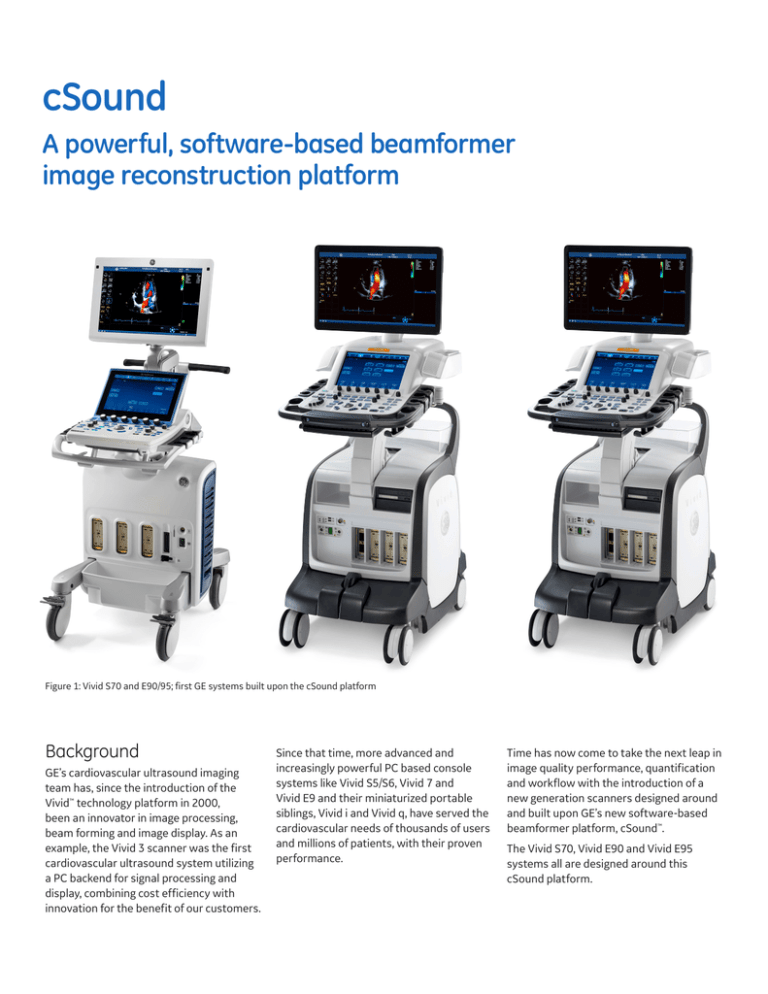
cSound
A powerful, software-based beamformer
image reconstruction platform
Figure 1: Vivid S70 and E90/95; first GE systems built upon the cSound platform
Background
GE’s cardiovascular ultrasound imaging
team has, since the introduction of the
Vivid™ technology platform in 2000,
been an innovator in image processing,
beam forming and image display. As an
example, the Vivid 3 scanner was the first
cardiovascular ultrasound system utilizing
a PC backend for signal processing and
display, combining cost efficiency with
innovation for the benefit of our customers.
Since that time, more advanced and
increasingly powerful PC based console
systems like Vivid S5/S6, Vivid 7 and
Vivid E9 and their miniaturized portable
siblings, Vivid i and Vivid q, have served the
cardiovascular needs of thousands of users
and millions of patients, with their proven
performance.
Time has now come to take the next leap in
image quality performance, quantification
and workflow with the introduction of a
new generation scanners designed around
and built upon GE’s new software-based
beamformer platform, cSound™.
The Vivid S70, Vivid E90 and Vivid E95
systems all are designed around this
cSound platform.
Fixed transmit/receive,
beam forming and
image processing
Vector data
Custom Hardware
PC
Probe
Raw data post
processing
Condensed vector data
Figure 2: TruScan and Accelerated Volume Architecture
Channel data
Fixed processing
Custom Hardware
Probe
TX
RX
Flexible processing
PC
Beam forming
Image reconstruction
raw data post processing
RF data from all probe elements
available for intelligent processing
Figure 3: cSound Architecture
cSound architecture
Every patient is different and anyone
working in medical ultrasound for some
time has experienced this. Even the
best ultrasound system may fall short
when used on a very difficult to scan
patient. The cSound architecture has
been designed from ground up to address
some of the fundamental limitations of
today’s ultrasound systems, aiming to
make imaging less patient body habitus
dependent.
GE’s cSound platform introduces a new
level of versatility, flexibility and processing
power in image acquisition, reconstruction
and visualization. The main component
in the new platform is a fully configurable
software-based image processing chain.
The figures below illustrate the TruScan
and Accelerated Volume Architecture
(Figure 2) used in our prior generation
scanners, as well as the cSound
architecture (Figure 3) used in our new
Vivid S70 and Vivid E90/95 scanners.
Proper preservation of the signals returned
from the probe through the system
electronics and software processing chain
is crucial in order to present diagnostic
quality ultrasound images to the users.
The processing chain starts with the
shaping of the transmit pulses to obtain
excellent axial resolution and penetration
with few side lobes to help reduce
reverberations, shadowing and other
acoustic artifacts. Receive amplification
is performed followed by high resolution
analog to digital sampling and conversion.
The next step in the processing chain is
the beamforming where data received
from the probe elements are delayed
and coherently summed. In conventional
scanners, ultrasound beam forming
is implemented with special purpose
hardware. Such ultrasound scanners can
therefore only support a limited set of
fixed and predetermined algorithms,
and new algorithms typically require a
lengthy hardware redesign. See figure 4
on below left.
In the cSound platform, all beam forming
processing is done in our back end
processor. This is where RF data from
each channel from multiple consecutive
and overlapping transmits are received
and temporarily stored in the “Local
Big Data” channel memory as shown in
Figure 4. Then advanced image formation
takes place. The algorithms and speed of
processing may vary depending on type
of console, probe, application and mode.
This processing is all software based. The
advantages this provides are flexibility
and the ability to quickly apply new and
innovative algorithms, and also adapts
them on the fly to the different modes
of operation.
Figure 4: Hardware vs. Software Beamformer
The number of processing channels
(“digital channels”) is traditionally defined
as a number proportional to the channel
count that can contribute to the coherent
beamsum. In the past, this was constrained
by the hardware architecture of the
beamformer and its associated processing
circuits. Now, with a software beamformer,
there is no practical limit to the amount
of channel data that may be stored and
recombined into a single vector, so the
number of processing channels is no longer
a relevant technical limitation.
cSound based features
and benefits
As mentioned before, the cSound
software-based beam forming architecture
has opened the door for the development
of features and functionality which has the
potential to change the way cardiovascular
ultrasound is used in the clinic. Below is
a selection of some of the features and
benefits enabled by this new platform,
introduced in this first generation cSound
based scanners from GE Healthcare.
True Confocal Imaging (TCI)
So-called “channel processing” where the
RF data from each element is kept for
further processing, can be used in the beam
forming algorithms to achieve enhanced
contrast as well as spatial resolution
throughout the field of view, in combination
with ultrahigh frame/volume rates.
Confocal imaging which previously was
implemented by use of multiple focal zones
originating from multiple transmits, is now
available without loss of framerate and
without the line artifacts usually present
as a result of multiline acquisition and/
or multifocus stitching. The need for a
dedicated focus control is made redundant
with this technology.
Key to this feature is the fact that the
transmitted ultrasound beams have an
hour glass shape which is wide laterally
both near and far, and receive data from
within these wide transmit beams are
collected and stored in the “Local Big Data”
channel memory. Multiple consecutive
transmit beams overlap in such a way
that data for each and every pixel exists in
many of the stored data sets in the channel
memory. By intelligently processing, the
algorithm is able to get an accurate realtime assessment of each pixel value. The
end output is, as mentioned, enhanced
contrast- and spatial resolution compared
to conventional beam forming algorithms.
In Figure 6, the left image is constructed
using the TCI algorithm as described
previously. On the right image, the same
data is accessed, but with the ACE algorithm
the pixel is observed over a short period
of time to determine whether or not
data for this pixel originated from a “real”
structure like in this example from the
atrial septum, or not. If the algorithm makes
the assessment that the data is real, then
it enhances the pixel intensity. If it’s noise
or artifacts, like in this example inside the
right ventricle, the algorithm reduces its
intensity. With the high degree of parallel
processing available this assessment is
done simultaneously for all pixels.
While this type of imaging without a
conventional focal zone control is not
unique to GE, our implementation provides
flexibility/versatility and easier adaptation
to new algorithms than those solutions
implemented in hardware/firmware. And
since our implementation is based upon
commercially available processors, as they
develop and are introduced into products,
this may then immediately transcend into
increased processing power, and ultimately
enhanced image quality with the potential
of enhanced diagnostic confidence and
other benefits that may arise from this.
The two internal images are combined to
achieve a high contrast resolution image.
In Figure 7, compared to the traditional
display image on the left, cSound’s TCI
and ACE combined image on the right has
greater clarity with enhanced spatial and
contrast resolution throughout the field
of view.
Adaptive Contrast Enhancement (ACE)
Adaptive Contrast Enhancement is the
second feature enabled by the cSound
architecture. As for True Confocal Imaging
data, any given pixel is first stored into the
“Local Big Data” channel memory. Once all
data from multiple consecutive transmits
are collected and stored in the “Local Big
Data” channel memory, the processor
accesses this data, and makes two
preliminary “internal” images.
Figure 5: True Confocal Imaging
Figure 6: ACE (right) enhancing real structures
Figure 7: The combined effect of TCI and ACE
compared to traditional (Vivid E9) beamforming
The cSound architecture benefits all
probes and applications including adult
cardiac (2D and 4D, TTE and TEE), pediatric
cardiac, fetal/obstetrics, abdominal,
pediatric, breasts, thyroid, adult and
neonatal cephalic, peripheral vascular,
musculoskeletal and urology/prostate.
Figure 8: GE Cardiovascular Ultrasound’s History of Quantification
Raw data format
4D imaging with cSound
4D Clarity
Historically the Vingmed scanners and the
GE Vivid product line introduction prior
to the year 2000, have always acquired
and stored its data in a specific raw
data format. This has enabled onboard
as well as after the fact post processing
capabilities which would be otherwise
impossible. This flexible and innovative
format (storage of pre scan converted
data) has enabled development of
utilities with high clinical value, like e.g.
Anatomical M-Mode - creating an angle
corrected M-Mode display from a 2D
dataset, and baseline shift in color for PISA
measurement done on color loops acquired
without baseline shift. The raw data
format has also been instrumental in GE’s
innovations in the area of quantification,
from tissue Doppler based techniques in
the late nineteen nineties and early two
thousands (TVI, Strain, Tissue Tracking, and
TSI), via 2D speckle tracking (2D Strain and
AFI) to 4D speckle tracking (4D Strain) later
introduced on the Vivid E9 platform.
Visualization engine
Access to channel data in combination
with recently developed advanced image
processing algorithms has facilitated a
new level of image quality, both from a 4D
rendering point of view as well as from
extracted 2D slice image quality view. The
cSound platform enables acquisition of
more data than what was the case with
our GE predecessors. Development of new
intelligent spatial processing algorithms like
4D Clarity provides crisp visualization with
excellent resolution/detail level (Figure 10).
In the progression of platforms (Figure 8)
for the above mentioned scanners more and
more image acquisition, image processing
and display processing were moved from
dedicated hardware to software. And over
the years this has resulted in an increase
in the ability to perform more and more
advanced algorithms for all steps in the
data processing chain.
It is important to understand that the format
of the raw data has not fundamentally
changed with the advent of the cSound
platform. The huge amount of data in
the “Local Big Data” channel memory
previously mentioned is discarded after
image reconstruction, so the stored raw
data file sizes are approximately of the same
size as before. A slight increase (20-30%)
may however occur, should the user take
full advantage of the higher spatial and
temporal resolution enabled by cSound.
An integral part of the cSound platform is
a completely new “visualization engine”.
The core of this engine is a dedicated
software module running on a Graphics
Processing Unit (GPU). GPUs are designed
for 4D processing in particular, but can
also be utilized for 2D graphical operations
as well as to offload the CPU in doing
computational operations.
The 4D processing chain has been
streamlined in order to do fast real-time
spatial processing, enabling development
and implementation of advanced
algorithms like 4D Clarity and HDlive™
described below (Figure 9).
Figure 9: 4D Clarity, HDlive and cSound acquisition provide excellent TTE and TEE images
Figure 10: 4D Clarity and cSound acquisition provide excellent extracted slices
HDlive
Algorithm overview
Direct lighting
The powerful CPU/GPUs required for RF
channel data processing also has enabled
real-time display of 4D images utilizing an
extraordinary rendering method, HDlive,
that generates an amazingly realistic
visualization of the human heart, through
advanced illumination, shadowing and
reflection algorithms. HDlive can be used
to enhance 4D depth perception during
image-guided interventions or in the echo
lab for “normal” TEE or TTE imaging. The
technology behind this feature is extremely
resource demanding, and is enabled by
the cSound platform and its powerful
processing capabilities, whether during
high volume rate single- or multi-beat
4D imaging.
The HDlive algorithm contains several
sub-features that are described below. By
following the sub-chapters and images
one can see how the image is constructed
step-by-step.
Direct lighting is applied to the scene
in order to create sharp shadows via
monochromatic light attenuation. These
shadows help with perception of small
details in the image. The image may
however become quite dark in several
regions if the light attenuation is very
strong. (Figure 13)
Depth coloring
Depth coloring is well known from the past
and frequently used for rendering volumes
in cardiac applications (both with TTE and
TEE probes). Depth coloring enhances
depth perception but does not give a lot
of detail. Depth coloring has, however,
previously not been integrated with diffuse
volume shadowing. (Figure 12)
Basically, HDlive is a real-time simulation
of light travelling through tissue giving the
user a realistic perception of the shape
of valves and other clinically important
structures (Figure 11) where a catheter
is visualized and illuminated by a light
source located at approximately 2 o’clock,
casting a shadow on the wall behind it. Also
notice how the surfaces reflect light, and
in combination with the light scattering
through tissue, create a three-dimensional
perception even when shown in the two
dimensional picture (Figure 11).
Figure 13: Direct lighting adds shadows, but certain
regions can become dark
Indirect lighting
Figure 12: Depth coloring by itself provides
limited detail
Indirect lighting is applied to create soft
shadows via diffuse chromatic light
attenuation. This part of the algorithm
simulates light scattering effects creating
soft-colored shadows. In the example
shown below, light attenuation for the blue
color is lower than the other colors, which
means that the diffuse shadows will be
bluish. (Figure 14)
Figure 11: HDlive visualizing a catheter during an
interventional procedure
Figure 14: Indirect lighting creates soft shadows
Ambient lighting
HDR processing
Ambient light is added to the scene to
lighten up the dark parts of the image. In
Figure 15, one can see a combination of
direct, indirect and ambient lighting.
Similar to what is implemented in stateof-the art cameras, HDR (High Dynamic
Range) processing is added to the image.
Basically this step greatly enhances
local contrast in shadow regions visually
extending the dynamic range of the
rendered image. (Figure 17)
Figure 15: Ambient lighting adds light to the
dark regions
Specular and diffuse reflections
Specular and diffuse reflections are
added to brighten up details. These are
simulating light reflections from the light
source hitting the surfaces and bouncing
back towards the eye. They are both
depending on the light direction, the local
surface orientation (normal) as well as
the viewing direction. Shown in Figure 16
are added specular reflections as well as
a bit of diffuse reflections to the previous
rendering.
Figure 17: HDR greatly enhances local contrast
Moving the light source
By moving the light source (easily
controlled by a rotary) the shadows and
reflections are adjusted interactively.
Shown in Figure 18 what happens when
the light source is rotated so that the light
comes from above (left image) and below
(right image)
Figure 18: Moving of the light source may enhance certain details
Figure 16: Specular and diffuse reflections brighten
up details
Summary
In many ways, the new cSound platform
is taking our raw data to the next level.
It does this by providing a magnitude
more information upfront for real-time
processing compared to what is available
in the previous platform. As computer
technology evolves, so will the processing
power of the cSound platform and its
imaging capabilities.
In this first generation cSound based
systems we have focused on
• developing new leadership scanners
with 2D (Vivid E90/95) and 4D image
(Vivid E95) quality and quantification
tools that may enable the user to reduce
the number of sub-optimal exams with
enhanced diagnostic confidence
• developing a new level of high
end scanners (Vivid S70) with the
performance of current GE leadership
systems, and further enhancing the ease
of use and portability of its predecessor
What the future will show is unknown,
but as you collaborate with GE on the
cSound path be assured that you are on a
fast moving track always striving towards
better and better patient care.
About GE Healthcare
GE Healthcare provides transformational medical technologies
and services to meet the demand for increased access,
enhanced quality and more affordable healthcare around the
world. GE (NYSE: GE) works on things that matter - great people
and technologies taking on tough challenges. From medical
imaging, software & IT, patient monitoring and diagnostics
to drug discovery, biopharmaceutical manufacturing
technologies and performance improvement solutions,
GE Healthcare helps medical professionals deliver great
healthcare to their patients.
Imagination at work
GE Healthcare
9900 Innovation Drive
Wauwatosa, WI 53226
USA
www.gehealthcare.com
©2015 General Electric Company – All rights reserved.
General Electric Company reserves the right to make changes in specifications and features shown herein, or discontinue the product
described at any time without notice or obligation.
GE, the GE Monogram, imagination at work, cSound, HDlive, and Vivid are trademarks of General Electric Company.
All third party trademarks are the property of their respective owners.
GE Medical Systems Ultrasound & Primary Care Diagnostics, LLC, a General Electric Company, doing business as GE Healthcare.
JB311156XX
ULTC-0284-06.15-EN-US






